Immersion Delivers a Needed Break from Reality
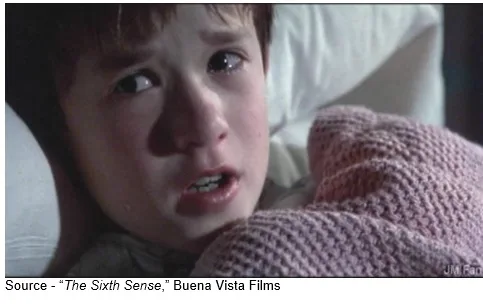
For a number of years during college we shared a house with foreign physics and chemistry grad students. To avoid studying, we’d get in these deep philosophical discussions on what reality and being really was.
You know, like “I’m real and you are a figment of my imagination or you’re real and I’m a figment of your imagination.” Or, we’d have existential discussions as to reality that we – and this planet –were really just a molecule of a still larger universe; and, in fact, a molecule in a chair in this still larger universe.
When we saw the first Matrix, we said, “Jeezz maybe our reality isn’t.”
After a year of hiding behind a mask, barricaded at home except for a few missions out, endless Zoom meetings and a constant barrage of real/shaky/fake “news,” we’re less certain.
We got swept back into the 4th/5th coming of VR for a couple of reasons.
First, it seemed that for the last six months, we’ve been seeing a resurgence of articles and news about VR finally (again) beginning to enter the mainstream world.
Second, the rush of annual film festivals always has some great VR projects we’d like to experience.
Of course, if you ask two of our expert acquaintances – Jon Peddie, Jon Peddie Research, and Mark Poppin, founder of BabelTechReviews – they’ll tell you to disregard the Zuckerberg/Facebook BS. Instead, focus on the three Cs – Content, Comfort, Cost.
No, the world won’t be running to escape to the better world as in Real Player One. Instead, there are great experiences being delivered for work, game play and visual storytelling.
“It’s so much better than what most people think,” Peddie huffed. “It’s not as dark and devious as Black Watch – https://tinyurl.com/1ekizmqw – and certainly isn’t like Bliss – https://tinyurl.com/4v79rhlv – that requires red/blue pills to hop between the worlds.”
Both Peddie and Poppin said the pandemic has been good for VR producers.
Peddie estimates that stand-alone VR headset sales grew about 30 percent last year and added that sales/use would have been even greater if the better-quality headsets (more expensive) hadn’t been on backorder most of the year because of chip/manufacturing challenges.
Because of, or in spite of, the CES announcements and upbeat news surrounding VR; Peddie has a theory about the technology.
“Remember when people used to talk about video conferencing at the turn of the century – it was always going to be a big market – someday …. and then, BAM! Here is it and free,” he reminded us.
“VR could be like that,” Peddie continued. “It will actually start with AR, just normal glasses, light weight, low cost, not anything you’d be embarrassed to wear in public. While sitting at a bus stop, bored, maybe agitated because the bus is late; you tap the side of your glasses, they go dark and your own private world lights up.
“It will happen, and your worlds will blur,” he said.
There are always a number of heady VR announcements at CES that make you believe it’s here and you’re the only one who missed the bus.
When we saw Panasonic’s, new VR glasses the first thing we thought of was Vin Diesel’s eyeglasses in Riddick.
But it doesn’t take long to think they’re so much better than the boxes.

According to Panasonic, this is the first VR solution that delivers UHD/HDR (ultra-high definition/high- dynamic range) viewing and includes 6DOF tracking for more freedom of natural movement.
The lenses are 2.6K micro-LED with individual diopter adjustment to compensate for the differences between your eyes.
We’ll be interested to see how VR purists take to the slimmed down glasses compared to conventional HMDs.
If the performance and experience are even close to similar, we like idea of entering an alternate world simply by sliding on a pair of glasses rather than a claustrophobic box strapped to our face.
What we enjoy about the constant over-the-top industry projections is that they focus on how good/great headset hardware is going to be rather than what’s important … content.
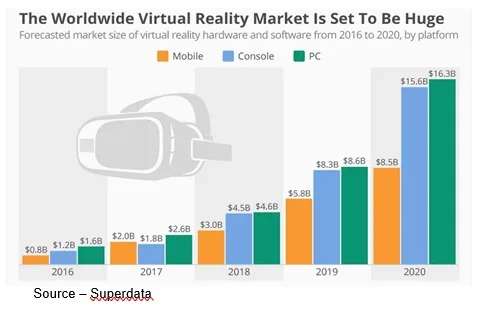
The disappointment to us is that they have been making – and adjusting upward – these projections for years.
Get serious, folks … wishing doesn’t make it happen.
Ever since Facebook dropped $2B back in 2014, analysts and VR zealots have predicted millions and millions of headsets will be used by people everywhere … in a few years.
VR just didn’t/hasn’t followed the new technology cycle where innovators brought along the early adopters who developed applications and entertainment that attracted the early majority followed by the late majority.
The defining opportunity was always just over the hill in gaming and immersive content experience that will open the floodgate.
It just never crossed Geoffrey Moore’s chasm – https://tinyurl.com/1byjsk8d.
We don’t say VR is a failure–far from it.
In fact, it is evolving into a segment solution that will entice and attract audiences as long as their experiences aren’t over-promised.
We found it interesting several years ago when we spent some time on Mars at the SMPTE conference with 20th Century Fox’s The Martian: VR experience.
Performing the tasks Mark Watney had to do on the red planet, driving the rover over craters and steering in zero gravity was neat but we really never felt as though we were actually there.
Andrew Cochrane’s Batman’s Skydive – https://tinyurl.com/2tomphq6 – unveiled during ComicCon a couple of years ago let you experience a skydiving wind tunnel.
The 360-degree video was the centerpiece of Batman’s 80th anniversary.
Andy and his longtime friend Andrew Shulkind have done some exceptional collaborative and individual VR work.
Despite the fact that companies have dumped billions of dollars into developing and refining the technology and its companion AR (augmented reality) they somehow miss the point that it’s the creative work game developers and filmmakers do that make all the difference.
They also seem to ignore the issues/problems consumers have with the technology.

The hardware shouldn’t get in the way of experiencing/enjoying VR but should actually make it seamless to move between the environments.
Better yet, it should totally immerse you in the new, different, alternate universe as it did for Keanu Reeves in Matrix.
You shouldn’t even know you have options.
We suspect that one of the reasons VR took such a jump in popularity this year is that people needed close/personal association with others.
Zoom calls are okay, but after two-three days of them … get real!

That’s probably why so many social VR apps have popped up around the web.
People can get together in a virtual space to battle monsters with/against each other or just sit down “together” and enjoy a VR film.
Simulated togetherness is fine but — especially during this past year’s lockdown — folks simply want to get away by themselves.
We were amazed at how many new personal VR opportunities are now available – nature treks, real VR fishing, VR travel, personal training (tons of them), holiday trips, remote adventures, and yes, … other stuff.

Escapism is VR’s strong suit.
Game developers have created experiences and challenges that appeal to people young/old, male/female. But still, to escape to an isolated location you need to be tethered to your computer or strap on an expensive/cumbersome computer.
The pandemic did a lot to push VR technology into the mainstream. But we think more credit goes to the creative program writers/producers who enabled folks to spend time in a new normal world where people could connect with people to play, work and enjoy stuff together.
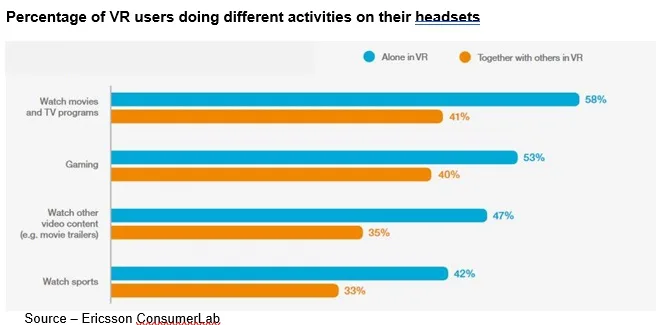
Slowly, VR is coming into its own.
Zuck noted late last year that 36 developers had made over $1M with VR content sales.
Quest 2 has surpassed the number of active users of the original.
While Peddie and Poppin both note that games are on a faster path to growth, we feel those players would like a more intense story beyond their first-person shooter.
The short-form narratives are becoming more inviting to folks who want to deep dive into the immersive world.
With the right marketing efforts, they should attract gamers and non-gamers.
Projects such as Half-Life: Alyx are gaining increasing attention with people who are interested in saving the earth.
In Half-Life, you’re directly involved and see/feel how your efforts fail or succeed. It easily becomes not just a story but reality for the viewer/player/participant.
Roger Ascher’s A Glitch in the Matrix was just one of a number of VR films from Argentina, Poland and the US shown at this year’s Sundance Film Festival.
 The documentary fit neatly into people’s concern today as to what is reality and what is simulation.
The documentary fit neatly into people’s concern today as to what is reality and what is simulation.
The documentary explains that everything from the chair you’re in, the thoughts in your head and the people you interact with can be reduced to lines of code.
A Glitch in the Matrix is a mix of philosophy, sci-fi and religion without making you understand the direction or ultimate answer.
Ascher makes it easy to question which world is real and which is simply human error.
If you want to stream it and test your own version of reality, A Glitch in the Matrix is available on iTunes, Amazon Prime, Vudu and Google Play.
Thanks to film festivals like Sundance, we’re reminded that filmmakers and Hollywood are still in love with VR and the technology has the potential for being a video story game changer.

The Consumer Technology Association (CTA) and the National Association of Television Program Executives (NATPE) recently released a report that optimistically says the future of VR depends on quality content.
The breadth of genres that can be adapted to the technology to generate content creation that can be monetized really isn’t limited.
In addition, it can be enhanced to make long-form storytelling more viewable, more viable.
Considerable experimentation and testing have been done – prior to the shutdown – with live sporting events and concerts. In fact, a number of franchise holders and promoters see these two venues becoming even more popular as the world emerges from the pandemic.
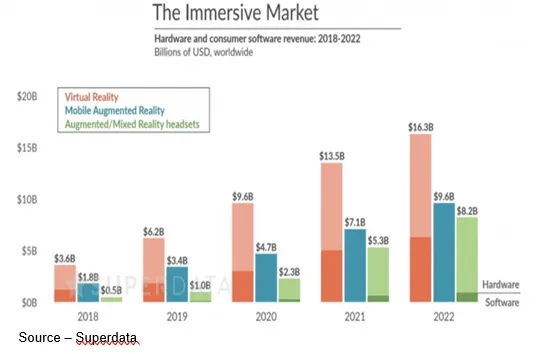
Perhaps largely because of the past year and people’s desire/need to escape and change scenery, VR has grown quite a bit.
Social sites like Altspace, VRchat and BigScreen have become gathering points where people develop/share new content and provide constructive feedback.
Part of the problem as Peddie and Poppin will quickly point out is that platforms such as Fortnite have become pseudo-VR venues for concerts and large virtual gatherings.
Travis Scott’s concert drew more than 12M viewers. Animal Crossing has become a quarantine hit. People are using Zoom and video-chat apps to hold “virtual” game nights, cocktail parties and yoga classes on their devices.
Nice but they really aren’t real VR immersive experiences.
Perhaps though they are the bridge activities Peddie feels people need to realize it’s time to cross the chasm and fully enter immersive games and movies.
Ultimately, VR will enable creatives to help viewers experience content from a personal perspective and make it their own.
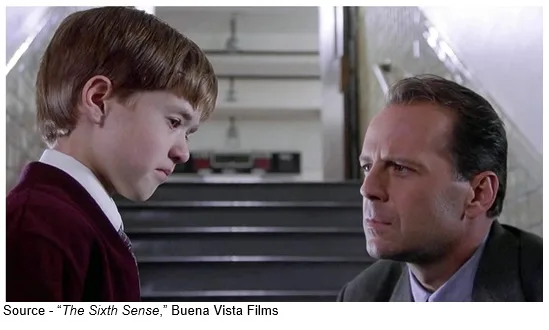 It sure will beat a 3D version of our kid’s first-person shooter.
It sure will beat a 3D version of our kid’s first-person shooter.
Then folks will be able to experience it all and know The Sixth Sense’s Malcolm Crowe meant them when he said, “Hey… you are not a freak. Don’t you believe anybody that tries to convince you of that. You don’t have to go through your life believing that.”
It’ll be a great break from the boring reality we just experienced.
# # #
Andy Marken – [email protected] – is an author of more than 700 articles on management, marketing, communications, industry trends in media & entertainment, consumer electronics, software and applications. Internationally recognized marketing/communications consultant with a broad range of technical and industry expertise especially in storage, storage management and film/video production fields. Extended range of relationships with business, industry trade press, online media and industry analysts/consultants.